Engadget has been testing and reviewing consumer tech since 2004. Our stories may include affiliate links; if you buy something through a link, we may earn a commission. Read more about how we evaluate products.
Xbox Series X review: A 4K beast in need of games
It’s basically a silent gaming PC in your living room.
The Xbox Series X is an apology for the Xbox One in almost every way. Microsoft's last console was weighed down by being $100 more than the PlayStation 4 at launch — even though it had less GPU power — and it featured a bundled Kinect camera that wasn't very useful. The company tried to course-correct with mid-generation systems, the Xbox One S and One X, but by then the damage was done. As of this year, the PS4 is estimated to have sold more than twice as many units as the Xbox One.
So with the Series X, Microsoft is trying to get everything right from the start. It's being positioned as the ultimate gaming console, with far more performance than its previous powerhouse, the Xbox One X. This new machine can deliver 4K gaming more reliably, push up to 120 frames per second, and load games far faster than ever before. It'll even play all of your old games with better performance and HDR! It's as if Microsoft is just begging gamers to love it.
The Xbox Series X is Microsoft’s ultimate gaming console, with the ability to deliver 4K games at 60 fps and beyond.
- Powerful hardware
- Near-silent fan
- An SSD speeds up load times
- Extensive backward compatibility
- Adds HDR to older games
- Launching without compelling games
- Few titles use ray tracing right now
And after playing the system for the past week, it's definitely something hardcore players will appreciate. It delivers most of what you'd want from a decent gaming PC, except it's in a convenient console box. But do you need one right away? Given that there aren't many compelling exclusives, that's a more complicated question.
Hardware: Putting the box in Xbox
Yes, the Xbox Series X is big, which seems to be the trend for this console generation. It measures 5.9 inches by 5.9 inches and stands about a foot tall, giving it an almost perfectly rectangular profile. It also weighs a hefty 9.8 pounds, over a pound heavier than the Xbox One X. We're used to Microsoft's recent systems being a bit boxy, but the Series is more like a shrunken computer case than something you'd expect to find underneath your TV. Once I got over the initial shock of seeing it in person though, I warmed up to it pretty quickly.
The Xbox Series X feels strong and sturdy — though not as dense as the significantly smaller One X. The case itself is made out of thick plastic, with minimal design flourishes. Up front, there's a disc slot, a single USB port and a controller pairing button, while the small Xbox power button sits in the corner. The one bit of flair you'll definitely notice is the giant fan exhaust at the top, which features an array of holes (a tryptophobe's nightmare) with neon green accents alongside one of the largest electronics fans you've ever seen.
You can orient the console vertically — where it truly gives off PC tower vibes — or horizontally. I appreciated the small rubber feet on one side of the system, which made it clear that it was meant to sit on the floor in horizontal mode. (This may seem like an odd thing to call out now, but keep it in mind for our PlayStation 5 review.) The only downside with that position is that the circular vertical stand is left sticking up, as if the Series X is a Star Wars Droid that's fallen and can't get up. In practice, that didn't bug me too much, but I've seen a few folks on Twitter wishing they could remove it entirely.
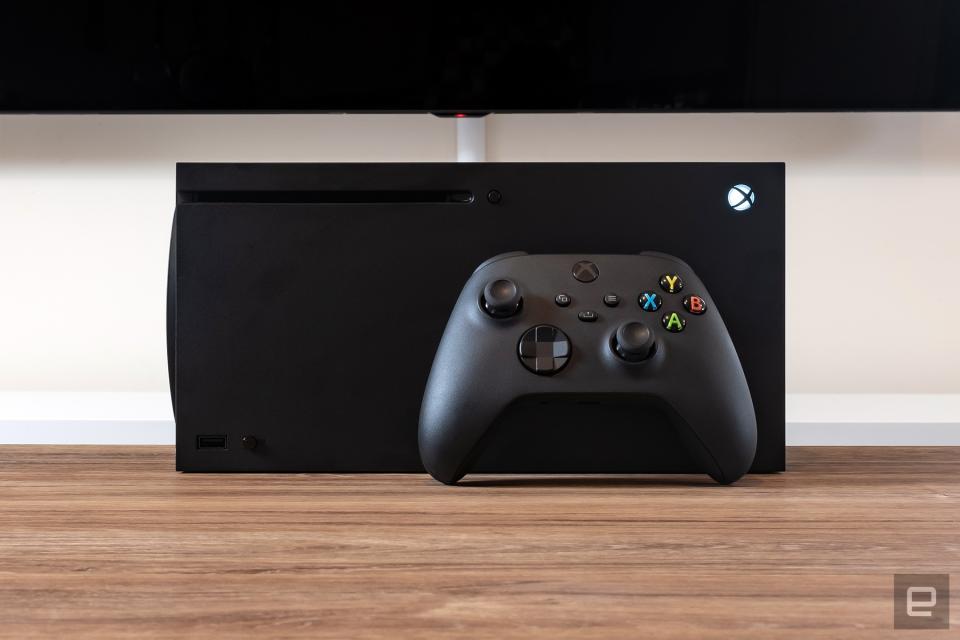
The Xbox Series X fit cleanly inside of my entertainment system when laying on its side. (Perhaps because it so closely resembles Logitech's large Hyperboom speaker, it seemed right at home alongside my Pioneer center channel speaker.) I just had to make sure to leave some open space for the fan to eject warm air. The Series X doesn't spew out as much heat as a gaming PC, but I'd bet it wouldn't be happy in a closed entertainment center. You've got to give all of your new consoles some room to breath, because they're pushing a ton of pixels.
So sure, the Series X just looks like a box. But it's what's inside that's truly compelling. The Xbox Series X is powered by a custom 8-core Zen 2 CPU running up to 3.8GHz and a powerful new 12-teraflop RDNA 2 GPU. That's impressive, but remember it's pretty much the same hardware that's inside of the PS5. The difference is that Microsoft’s console has a larger GPU to eke out a couple more TFLOPs of performance. While they both offer 16GB of fast GDDR6 RAM, Microsoft offers faster bandwidth than the PS5 for 10GB of that memory. The remaining 6GB, meanwhile, runs slower than Sony's console.
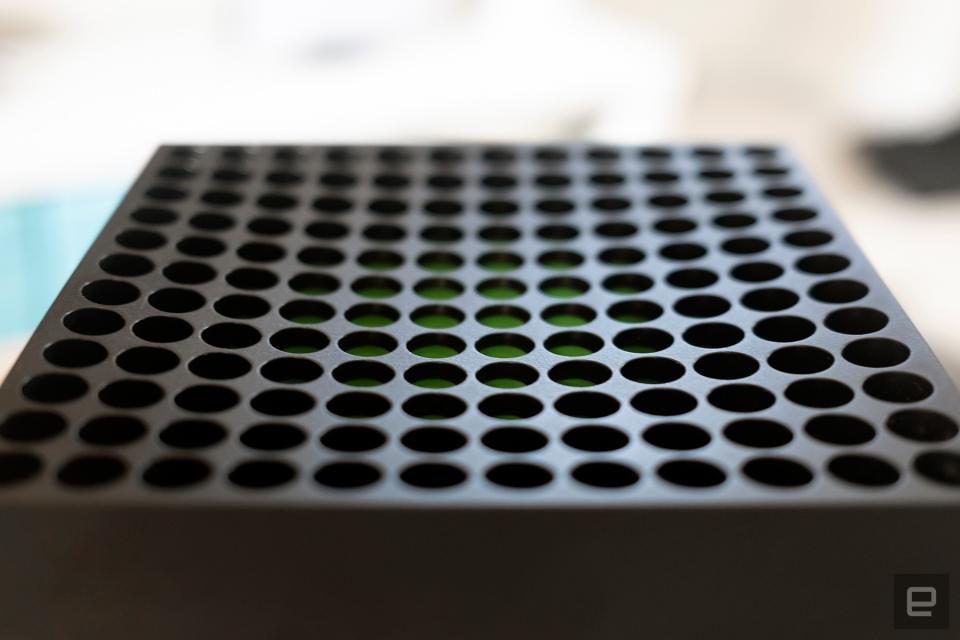
The Series X also features a speedy 1TB NVMe SSD, which is light years faster than the slow mechanical drives in the previous Xbox consoles. If you've moved from a laptop with a traditional hard drive to an SSD, it's pretty much the same leap. The Xbox Series X is able to move large data files much faster and with less latency, which is key for the massive textures 4K gaming demands. You can also expand the system's storage with Seagate's $220 1TB expansion drive, which fits into a rear slot on the console. That drive may seem expensive today, but that's not too far off high-end NVMe SSDs for PCs, and it'll deliver the same speeds as the internal SSD.
Additionally, you can use a standard USB 3.1 external hard drive for "cold storage" for Series X games, though you'll have to move them to the internal SSD or Seagate expansion drive to play them. Older backwards compatible games, meanwhile, can be played right from the USB drive, though load times will suffer.
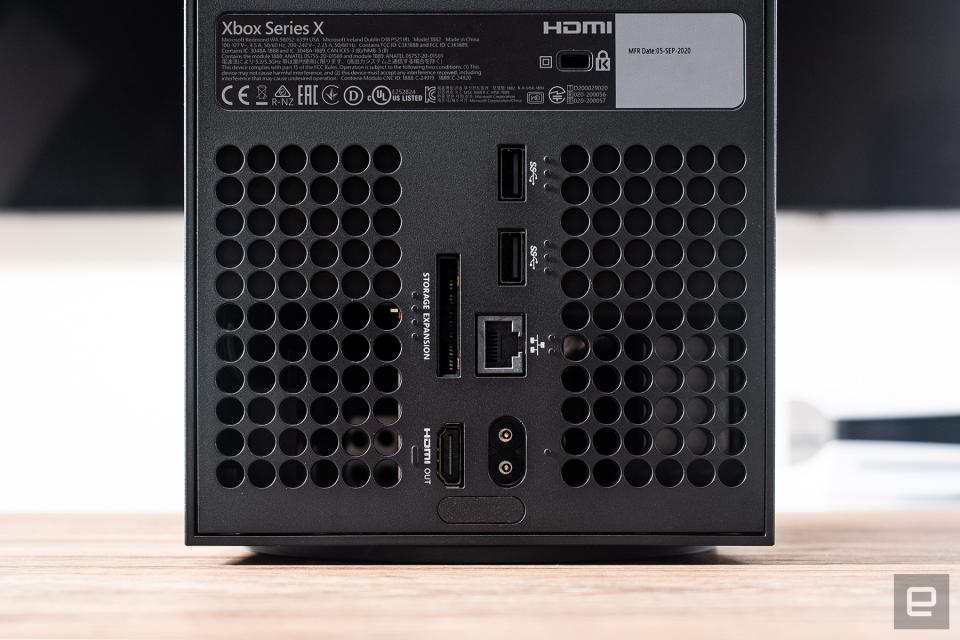
While Microsoft clearly put a ton of thought into the Series X's overall design, the new controller is only slightly different than before. There's a circular directional pad that's satisfyingly clicky, a share button sandwiched below the two middle buttons, and some rough bumps along the underside of the handles to help with grip. It runs on two AA batteries, as usual, and holds a charge as long as existing Xbox gamepads, lasting three-ish days with regular use for me. The company basically lifted as many ideas as it could from the Xbox Elite Controller without changing the overall design of its standard gamepads. Xbox fans will be right at home here, but after seeing the amount of innovation Sony stuffed into the DualSense, it's disappointing that Microsoft didn't deliver anything truly special with its new high-end console.
Getting started: Waiting game
Setup is pretty simple: Settle on vertical or horizontal mode, plug in the power and bundled HDMI 2.1 cord, and turn the system on. You can use the Xbox mobile app to configure WiFi and other settings, though in practice that failed half-way through for me. While it worked fine to connect to my WiFi, the app lost sync with my console afterwards, so I had to complete the setup using my controller. That was easy enough, but it was disappointing to have one of the first "next gen" aspects of the system fail right out of the gate.
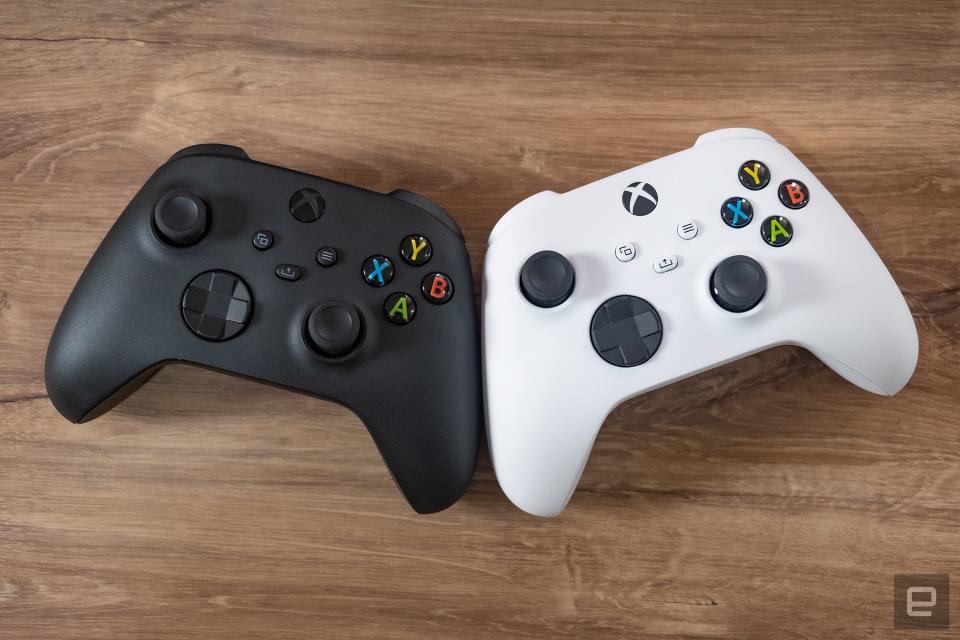
Once the system booted up with the familiar Xbox One chime (and an impressive new launch sequence), I was thrust into the new Xbox user interface. And thankfully, it's nothing like the last one: I was able to fly through menus, load up store pages, and navigate my large library of games with ease. For once, it felt like I was racing to keep up with the speed of the system, instead waiting for it to catch up to me, like the previous Xbox One lineup. The new interface (which is also available on the earlier systems) looks great overall, with an emphasis on large images and simple navigation. The one downside is that it’s rendered in 1080p, instead of 4K like the PS5’s, but in practice that’s not something I noticed much. Though it could be an issue if you sit very close to the screen.
As with every modern console, I couldn't just get straight to gaming. My first task was to nab a required system update, which took around five minutes. Then I started downloading everything I needed to play. That included some new Xbox Series X enhanced titles, like Dirt 5 and Yakuza: Like a Dragon, along with older games like Red Dead Redemption 2 and Geometry Wars: Retro Evolved (yes, seriously). And then I just had to... wait. Downloads over my WiFi connection came at a steady 100 Mbps, which was fast enough to install a 75GB title like Forza Horizon 4 in an hour or two, depending on whatever else was going on in my network.
I just queued up a bunch of games and let the system do its work overnight, but I'm sure kids and parents would be crestfallen when they discover how long it'll take to actually play something. (That's something Sony avoided a bit with the PS5, since it preinstalled Astro's Playroom on every system.) So here's a PSA for every parent out there: If you're gifting an Xbox Series X, or any modern console for that matter, be sure to set up the system beforehand, download the necessary updates, and install every game you're planning to give your child. And if possible, do it overnight while connecting to your router over Ethernet.

In use
Okay enough table setting, how well does the Xbox Series X play games? In a word, spectacularly. In a preview version of Dirt 5, there's an extra level of detail throughout its different cars and terrain, especially if you're racing through a wet and muddy roadway. It features three different modes for graphics: one focused on maintaining a solid 60 fps frame rate with a dynamic 4K resolution, another on delivering higher image quality in 4K/60 fps, and one devoted to delivering a blazing fast 120 fps experience. You'll need a modern HDMI 2.1 display with 120Hz support to run the latter mode, otherwise you won't even see it in the menu.
While testing the game on LG's 48-inch CX OLED, every mode looked fantastic. But I generally leaned towards the framerate mode, which maintained a steady 60 fps better than the image quality mode, which traded a bit of a performance dip for higher quality shadows and reflections. I was surprised to see 120 fps support in a launch Series X game, and that performed even more smoothly than the other two modes. With a higher framerate, the game is even more responsive when you're zipping along roads at high speeds. But I didn't think the loss of graphical fidelity was worth the extra frames — 60 fps was smooth enough for me.
I can't stress this enough, the leap from 30 fps performance on older consoles to 60 fps is a night and day difference. While a handful of games delivered that higher framerate on the Xbox One X and PS4 Pro, now it's practically a requirement. It's not subtle like the jump to 4K rendering. At 60 fps, gameplay just looks smoother, and everything reacts more quickly to your inputs. The jump to 120 fps takes that concept even further, but it's not nearly as transformative as the difference between 30 and 60 fps.

Gears 5, which is optimized to run on the Series X, feels like a completely new game. The campaign and cutscenes now run at 60 fps with a dynamic 4K resolution, and they both look better too with support for ray-traced lighting and higher graphical settings across the board. I honestly had a hard time telling the difference between the game running on the new console and on my gaming PC with an RTX 3080. Notably, the PC version of Gears 5 doesn't even have that ray tracing feature yet.
On Series X, the game also loads levels in around 10 seconds, instead of the upwards of 30 seconds it took on the One X. That's purely the benefit of running off an SSD — the game doesn't support the full capabilities of the console's faster "Velocity" architecture just yet. But it's a reminder of just how big the leap can be when you move away from a mechanical hard drive.
Gears 5 also supports 120 fps in the multiplayer mode, which strips away some graphical fidelity to make room for more frames. It was the smoothest I've ever seen the game — rolling around enemies, mowing them down with shotguns and trading cover fire never felt better on a console. A higher frame rate also means less latency, which was particularly useful when aiming for headshots with sniper rifles. It's as if there's nothing getting in the way between your button presses and the game's on-screen response. The smoother the framerate, the more your gamepad feels like an extension of your body.
While I was mowing down baddies in a massive Gears 5 set piece, I also noticed something strange: the Xbox Series X is practically silent. It turns out, that giant fan, and the system's tower aesthetic, do a solid job of cooling things down without making much noise. Perhaps future games will make the fan kick up more, but I couldn't make it any louder than a pleasant whir no matter how hard I tried.
Yakuza: Like a Dragon also offers three different performance modes, focusing on 4K rendering, a high 60 fps frame rate, and a balanced normal mode, which runs near 60 fps while balancing graphical fidelity. Every mode looked good, though, as always, I leaned towards the higher framerates. Even on a new TV like the CX, the immediate benefits of more frames are far more noticeable than native 4K rendering.
I'll admit, I didn't have many games to try that truly took advantage of the system's capabilities. At the time of this review, I couldn't play upcoming titles like Watch Dogs Legion and Assassin's Creed: Valhalla. And of course, Microsoft's one intriguing launch title, Halo Infinite, is now delayed until next year. Some first party games, like Forza Horizon 4, run more smoothly on the system, but there wasn't a huge difference in visual fidelity from the Xbox One X version. A handful of titles though, like Sea of Thieves, get a better upgrade to 4K/60FPS, over lower rendering or 30FPS.
Even if a game isn't optimized for the Series X, it'll still benefit from running on a speedy SSD and having the headroom of a modern GPU. Red Dead Redemption 2, in particular, loaded a full minute faster compared to the Xbox One X. Getting into the game still took around 30 seconds, which isn't the lightning fast next-gen experience I was looking forward to, but at least it's better than the 90-plus seconds on the old console. Red Dead 2 also ran in 4K at a steady 30 fps, with no performance dips. I'm hoping Rockstar spends some time optimizing it for new consoles so we can see a 60 fps option and more graphical flourishes.
The Series X's backwards compatibility with Xbox One, 360 and even original Xbox games is another draw. That's a nearly 20-year library of titles to play, all of which will get some benefit from the new console's hardware. Again, faster load times is key, but Microsoft can also dynamically add HDR to older games, a unique feature I've never seen before on any hardware. It's not just like the faux-HDR settings you may have on your TV: It relies on AI to add lighting highlights where appropriate. That made playing games like Geometry Wars: Retro Evolved and Alan Wake transformative. Bright lights almost popped off my OLED screen, and it made me excited to try other old titles on the system.
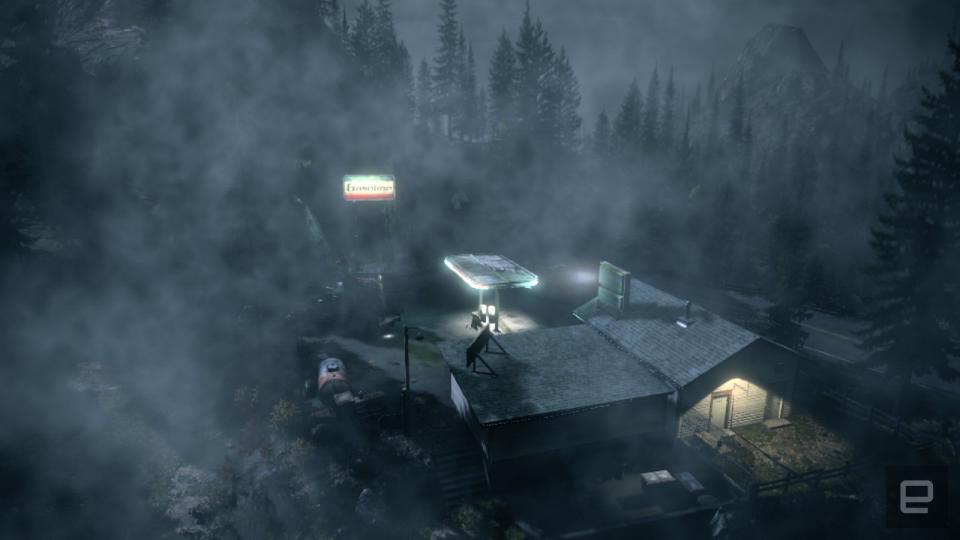
It's occasionally buggy — sometimes Alan Wake would blow out lights through a window inappropriately — but the overall experience was still impressive. I hope Microsoft eventually adds the ability to tune those HDR settings though, something that's fairly standard with HDR-enabled games. And it'd be nice to turn off the feature entirely for those who want to preserve the original game experience.
As I tested out multiple games, I quickly learned how powerful Microsoft's Quick Resume feature can be. It lets you jump right back into a game from where you left off, rather than restarting it through their title screen. I was able to move from Red Dead Redemption 2 to my Gears 5 session in about five seconds. After that, it took just three seconds to jump back into Alan Wake. You’re limited to however many games it takes to fill up the system’s cache, and not every game fully supports Quick Resume just yet, so just make sure to save regularly. Microsoft attempted to deliver a similar capability with the Xbox One, but it was so unreliable I never used it. At least this time, it seems rock solid and genuinely useful.
And speaking of older games, you've got access to a ton of them through Game Pass, Microsoft's subscription service that grants you access to a large library of titles. That includes access to first-party games, a rotating set of popular games, select titles from EA Access and eventually Bethesda games. I've argued before that it's one of the best deals in gaming today, especially if you're paying for Game Pass Ultimate, which includes Xbox Live multiplayer for $15 a month. Xbox All Access, which includes Game Pass Ultimate along with a no-interest loan for the Series S or X, is arguably the best way to get one of the next-gen systems.
Game Pass isn't a requirement for Series X owners, but I'd strongly recommend it. That's especially true if you're a parent who doesn't want to go bankrupt buying your kids new games every week.
Of course, the Series X can do more than just play games. It can play 4K Blu-rays just fine, and it supports all of the streaming video apps you'd expect, including Apple TV. Thanks to its more powerful processor, navigating video apps felt faster than the One X, but that's clearly not a demanding task since even budget streaming boxes are fairly zippy these days.
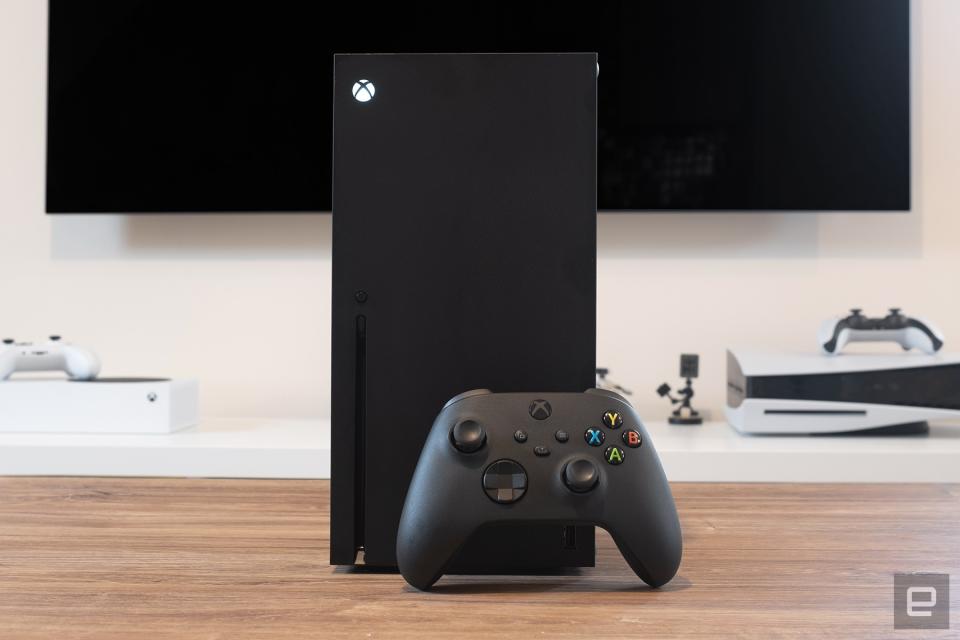
So, do you need one?
As impressed as I was by the Series X, even I'll admit there aren't many compelling new games to make it a "must buy" $500 system. At least it's less of a niche upgrade than the One X, which only offered slightly faster GPU performance. If you've managed to survive with an original Xbox One, or the One S, you'll see some huge performance upgrades from the Series X. And I'd imagine Xbox One X owners, at least those demanding the best performance, will see a need to upgrade.
And here's the thing, if you've got an older 4K or 1080p TV, and you don't see yourself upgrading anytime soon, the Series X may be too much console for you. That's where the cheaper $299 Series S comes in. It'll run every new Xbox game, but it'll just aim for a lower resolution. And it still comes with all of the other advantage from the Series X, like backwards compatibility, automatic HDR, and a fast SSD. The big downside is that it only comes with 362GB of storage available from a 512GB drive, which limits the amount of games you can fit without spending more on an additional drive. And if you're spending $220 on Seagate's 1TB expansion drive, you might as well just get the Series X.
At this point, it's hard to compare the Series X to the PlayStation 5, mainly because we can't discuss everything Sony's system offers. But if you just care about impressive next-generation games, like Spider-Man: Miles Morales and the Demon's Souls remake, it may be the better option for you. But that's not a real surprise — Sony's consoles have always excelled when it comes to big-budget exclusives. It's a shame Microsoft couldn't line up enough games to tempt away a stubborn Sony fan. But that's understandable, considering how difficult things are for developers, and everyone really, during the coronavirus epidemic.
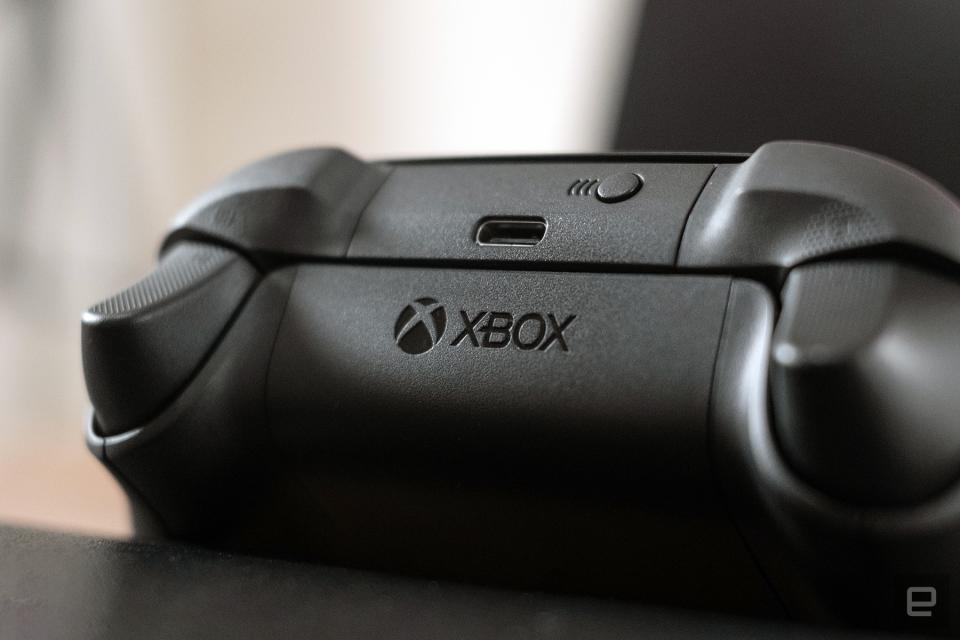
Wrap-up
The Xbox Series X is everything the Xbox One wasn't. It's fast in every way, it handles 4K gaming with ease, and it obliterates lengthy loading times. It's purely focused on delivering the best gaming experience possible, instead of being a half-hearted all-in-one entertainment device. The only problem is there aren't many compelling games at launch, which leaves Microsoft a bit flat-footed against the PS5. Still, even without many exclusive games, the Series X will run many existing games just as well as a modern PC. And for many gamers, that's enough.
Jessica Conditt contributed to this review.
